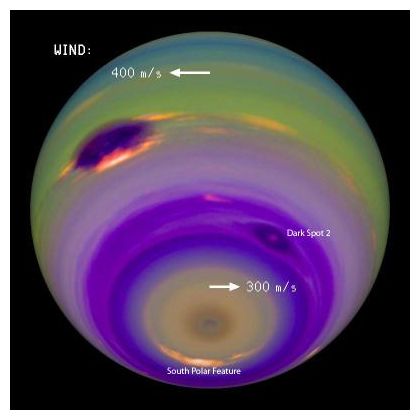A planetary scientist at the University of Arizona has determined Neptune's rotation.
According to the first accurate measurements of the planet's rotational period, a day on Neptune lasts about 15 hours, 57 minutes and 59 seconds.
University of Arizona planetary scientist Erich Karkoschka has discovered one of the largest improvements in determining the rotational period of a gas planet in almost 350 years since Italian astronomer Giovanni Cassini made the first observations of Jupiter's Red Spot.
"The rotational period of a planet is one of its fundamental properties," Karkoschka, a senior staff scientist at the UA's Lunar and Planetary Laboratory, said in a statement. "Neptune has two features observable with the Hubble Space Telescope that seem to track the interior rotation of the planet. Nothing similar has been seen before on any of the four giant planets."
Giant gas planets rotate more like giant blobs of liquid, unlike rocky planets, which behave like solid balls spinning in a more straightforward path. Gas planets' rotation involves a lot of sloshing, swirling and roiling, which has made it difficult for astronomers to get an accurate idea of how fast they spin around.
"If you looked at Earth from space, you'd see mountains and other features on the ground rotating with great regularity, but if you looked at the clouds, they wouldn't because the winds change all the time," Karkoschka said in a statement. "If you look at the giant planets, you don't see a surface, just a thick cloudy atmosphere."
"On Neptune, all you see is moving clouds and features in the planet's atmosphere. Some move faster, some move slower, some accelerate, but you really don't know what the rotational period is, if there even is some solid inner core that is rotating."

Astronomers discovered in the 1950s that Jupiter sends out pulsating radio beams. Those signals originate from a magnetic field generated by the rotation of the planet's inner core.
Other gas giants' radio beams have not available because any radio signals they may emit are being swept out into space by the solar wind and never reached Earth.
"The only way to measure radio waves is to send spacecraft to those planets," Karkoschka said. "When Voyager 1 and 2 flew past Saturn, they found radio signals and clocked them at exactly 10.66 hours, and they found radio signals for Uranus and Neptune as well. So based on those radio signals, we thought we knew the rotation periods of those planets."
Karkoschka discovered that two features in Neptune's atmosphere stand out in that they rotate about five times more steadily than Saturn's hexagon.
The features are likely vortices swirling in the atmosphere, similar to Jupiter's famous Red Spot. Karkoschka was able to track them over the course of over 20 years.
"The regularity suggests those features are connected to Neptune's interior in some way," Karkoschka said. "How they are connected is up to speculation."
One theory involves convection driven by warm and cooler areas within the planet's atmosphere.
"I thought the extraordinary regularity of Neptune's rotation indicated by the two features was something really special," Karkoschka said.
The discovery is published in Icarus, the official scientific publication of the Division for Planetary Sciences of the American Astronomical Society.




Reader Comments
to our Newsletter